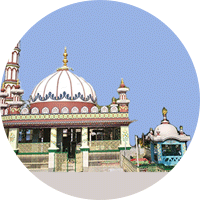Forty-Sixth Assembly (Khwan-Pur-Nemat)

Forty-Sixth Assembly (Khwan-Pur-Nemat)
Sheikh Sharfuddin Yahya Maneri
MORE BYSheikh Sharfuddin Yahya Maneri
It was the feast day. In the congregation presided over by the Qazi at the place for feast-day prayers, a scholar said: The offering of auxiliary prayers at this place before the official ones is not proper. Yet this tradition is current concerning prayer in a mosque: 'When you enter a mosque, perform two prostrations of prayer.' Hence it is that one should immediately on arriving at the festal carpet offer two cycles of formal prayer.
The scholars discussed this point. Finally, the prayer-leader rose up to lead the feast-day prayer.
When the prayer was over the Master returned to his own blessed residence and sat down. The scholars of the city all came crowding in together and sat down. Before the festal meal the Venerable Master said: I heard that, in the Qazi's congregation, a discussion arose and one of the scholars asked which path you entered by quarreling, prohibiting, or opposing? Now what need was there for all that talking and listening? The answer is found in the following tradition: 'When you enter a mosque, perform two prostrations of prayer. A place for feast-day prayer is not a mosque. It is not 'entered'. Besides, nobody calls this place a 'mosque'. It is not regulated by the rules for mosques, except for one hour on the two major feast days. One of the rules is to line up correctly without crowding the rows together, and the others are to be observed.
Those present in the assembly bowed to the earth, saying: That is the way it is. The answer has been given by the Venerable Master.
NOTES AND REFERENCES
1. 'Makrooh Ast'. (This whole assembly is found in AC & D, but not in E, while B is incomplete).
2. There is usually a large area, sometimes enclosed by a very low wall, with a higher one on the side facing Mecca. It is used only on the two main feast days when all the men of a town gather for the special 'Id prayers. The place is called an 'Eid-gah not a 'mosque.
3. The reference is to the rows of worshippers.
It was the feast day. In the congregation presided over by the Qazi at the place for feast-day prayers, a scholar said: The offering of auxiliary prayers at this place before the official ones is not proper. Yet this tradition is current concerning prayer in a mosque: 'When you enter a mosque, perform two prostrations of prayer.' Hence it is that one should immediately on arriving at the festal carpet offer two cycles of formal prayer.
The scholars discussed this point. Finally, the prayer-leader rose up to lead the feast-day prayer.
When the prayer was over the Master returned to his own blessed residence and sat down. The scholars of the city all came crowding in together and sat down. Before the festal meal the Venerable Master said: I heard that, in the Qazi's congregation, a discussion arose and one of the scholars asked which path you entered by quarreling, prohibiting, or opposing? Now what need was there for all that talking and listening? The answer is found in the following tradition: 'When you enter a mosque, perform two prostrations of prayer. A place for feast-day prayer is not a mosque. It is not 'entered'. Besides, nobody calls this place a 'mosque'. It is not regulated by the rules for mosques, except for one hour on the two major feast days. One of the rules is to line up correctly without crowding the rows together, and the others are to be observed.
Those present in the assembly bowed to the earth, saying: That is the way it is. The answer has been given by the Venerable Master.
NOTES AND REFERENCES
1. 'Makrooh Ast'. (This whole assembly is found in AC & D, but not in E, while B is incomplete).
2. There is usually a large area, sometimes enclosed by a very low wall, with a higher one on the side facing Mecca. It is used only on the two main feast days when all the men of a town gather for the special 'Id prayers. The place is called an 'Eid-gah not a 'mosque.
3. The reference is to the rows of worshippers.
Additional information available
Click on the INTERESTING button to view additional information associated with this sher.
About this sher
rare Unpublished content
This ghazal contains ashaar not published in the public domain. These are marked by a red line on the left.
